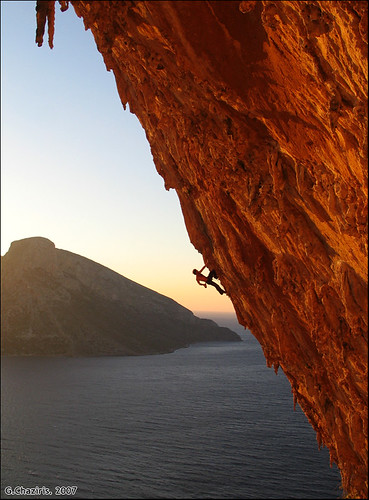9b
world CLIMBERS party
Kalymnos sport climbing AREA

Over the last few years Kalymnos, a small mountainous island in the southeastern Aegean Sea, about 300 km south east of Athens, has gained a reputation as one of the best sport climbing venues.
Getting there by airplane:
a) direct fly to kos with Ryanair from Bergamo and Frankfurt
b) direct daily (at least one everyday all year long) flights to Kalymnos from Athens with Olympic airlines (35 min) for about 150 euros to go and come back.
Flights in bad or windy weather are not allowed and often cancelled.
c) daily flights per day from Athens to the nearby Kos, safer option:
there are 3-4 daily flights from Athens, by Olympic or Aegean Airlines
d) in high season (may to october) there are cheap charter flights from several European airports.
From Kos airport:
You can go to the nearby (10 minutes drive) Mastihari port by bus (only operating in the high season) or taxi (about 12 euros).
From Mastihari port:
you can catch a ferry to Pothia (the capital of Kalymnos), that takes 25 to 45 minutes, costs about 4-6 euros and runs 3-4 times a day.
Ferries do not operate in bad weather, but if You are more than 10 persons, it's possible to get on an unofficial boat for about 20 euros per person (ask the locals around the port).
From the Athens airport, You have another option to go to Kalymnos:
get the metro to the port of Piraeus.
From piraeus port, You can catch the daily evening ferry to Kalymnos (10-11 hours), for a least 40 euros per person one way.
Best period
- September to November: good weather and temperature, dry rock, warm sea, many accommodations and restaurants.
- March to May: much cooler than in the autumn, rain is more frequent and tufas can be dripping after a rainy winter.
- Summer: hot, you can climb in the shadow in the morning and the late afternoon/evening.
- Winter: mild, but could be windy and of course with more rain than other seasons. In winter you do not have to queue for the popular routes and the friction is perfect. Some sectors (like Grande Grotta) stay reasonably dry even during (and after) heavy rain.
Discussion: Kalymnos or Spain in winter ?
Kalymnos from MDM on Vimeo.
Accommodation
There are no campsites in Kalymnos and wild camping is prohibited.
You can decide between:
1) hotel rooms (normally around 30-40 euros per night for 2 persons)
2) small apartments, locally called "studios" (normally around 25-35 euros per night for 2/3 persons)
Prices depend on the season, You can barter cheaper rates if You stay for a long term.
Some apartments have just a small fridge and hob cooker, some others have proper kitchen, so is better to choose them basing on personal recommendations:
- Kokkinidis and Fatolitis, right at the top end of Armeos, near Massouri
- Babis, right at the far end
- Mikes Bikes in Massouri, reasonably cheap and very close to the crags
- Lili and Manolis, 40-50 euros per night, negotiable if less than 4 people, in Kamari (around 1.5 km from Massouri and 5 km from Pothia), two twin bedrooms, a large fully equipped kitchen, a large terrace with view over Telendos, the owners (liligeo@hotmail.com) can pick you up for free from the airport or the port.
In the Municipality of Kalymnos website You find a list of other accommodation options.
Flats in Armeos and Massouri are within walking distance (20-45 minutes) from some of the crags (Zeus, Poets, Iannis, Kalydna, Ivory Tower, Stankill, Panorama, Grande Grotta, Afternoon, Spartacus, Jurassic Park), so You don't need car or scooter.
The nearest building from Grande Grotta is about 15-20 minutes walk.
If you are hiring a scooter or driving, or you do hitchhike (quite easy) you can get slightly cheaper accommodation around the coast around Arginonta or Emborios.
If You need a place to stay for a very long time (for example, all the winer:
- triantafillos, fanimixalsi@yahoo.gr
- studio alkyon, alkyon2@otenet.gr
- afroditi studios, info@kalymnos-afroditihotel.gr (total self catering in this period)
Eat and drink
You can expect to spend for food 15 euros per person at normal-priced restaurant, much lower (appr. 8 euros per person) if you cook in the apartment.
There are many good cheap restaurants around the Island.
You can have starter + salad + main course + a glass of greek wine for less than 10 euros.
There are some excellent fish restaurants offering the catch of the day, look for the best around Pothia port.
You have to try: a Greek salad, the Moussaka, the stuffed wine (or cabbage) leaves, the Chevalier de Rhodes wine.
Most places in or around Massouri are closed in the winter, only a couple of places remain open.
There are quite a few bars on the island, unfortunately open in winter just around Pothia.
Tap water is not drinkable, you can fill your bottles in one of the natural springs (there is a natural spring water tap in Pothia, by the main road, on your right when driving towards the port and two in Masouri).
Of course You can buy bottled water.
There are a few good supermarkets on the Island.
The closest large supermarket to the climbing areas is in Panormos, there are a few others in Pothia.
Supermarkets around Massouri are smaller and generally more expensive (most of them being closed in the winter).
Getting around
If You don't stay in Massouri or Armeos, to move around the island you can:
- hitchhike (quite easy)
- hire a car or a scooter (cheap, below 10 euros per day).
In a scooter, You can easily fit 2 people plus two rucksacks (one rucksack can go between the feet of the driver).
An helmet is a must to avoid a 350 euros fine ... it's provided for free from most hire companies and a climbing helmet is accepted.
There are no petrol stations north of Panormos.
- take public bus between Pothia and Massouri but not very regular.
You can expect to pay approximately 125-175 euros per week per person.
English:
Francais:
The climbing
More than 800 pitches in more than 40 sectors.
Main concentration on the west coast of Kalymnos (between the villages of Kalimari and Skalia) and on the nearby island of Telendos.
Excellent clean, mostly steep limestone with tufas, stalactites, pockets, ...
Skills required:
- good stamina and technique
- a little of "pain tolerance" for the knee bars
The 2010 edition of Aris Theodoropoulos’ guidebook can be bought (38 euros) here.
The beginning of the approach to most sectors is indicated by white pillars by the main road which lists the sectors which are approached from there and give information on walking time and colour used for marking the path.
A 70 meter rope plus 15 quick draws should be sufficient for most routes, although for a few routes, especially in the Grande Grotta, you may need more than 20 quickdraws and an 80 m rope.
The nearby island of Telendos has some good climbing too.

Links:
- ClimbKalymnos
- Planetmountain.
- Charlotte Durif.
- rock climbing in Greece
- Climbing school.

Tags:
Replies to This Discussion
-
Permalink Reply by 9b on August 29, 2012 at 10:58pm
-
Ferry Kalymnos - Athens: http://www.bluestarferries.gr/site/content.asp?sel=&loc=2

-
Welcome to the world of CLIMBERS
How to participate in this site at a 9b level
The really first ever film with Adam Ondra: http://www.youtube.com/playlist?p=PL80AA5B5B12EB7BFD
Blog Posts
Sell on 9b your climbing topos to other world climbers !
Posted by 9b on March 1, 2013 at 4:00pm 0 Comments 0 Likes
27crags, climbervoice, 8a and many others are amazing sites, but sometimes, expecially if you worked a lot to envision, bolt, clean routes or boulders, you want to monetize a little your efforts.
9b can help you in this aim.
As you can see here, in 9b there are many " topo groups ".
You can add a discussion in every "topo group".
In your discussion you can edit and publish your own climbing topoguide, as a "paywall", a "destination page", requiring climbers their payment by credit card or paypal to access and read, even on SMARTPHONES (iphones, android phones, ...)

After having paid, climbers can see, save and print your climbing topoguide.
In this discussion you can add:
1) PHOTOS regarding one specific SECTOR (of routes or bouldering, dws lines)
a) "PHOTO topo":
It's very easy to edit a photo topo:
- upload a photo of a rock in a topo group discussion
- drawn the lines
- write names and grades (an example…
Continue
© 2025 Created by 9b.
Powered by
![]()